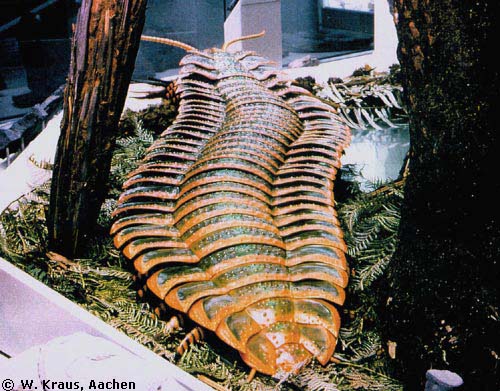Skip to comments.
Spectacular specimen: This bug's a big one - 8 feet long - and New Mexico scientists nabbed...
Albuquerque Tribune ^
| April 14, 2005
| Sue Vorenberg
Posted on 04/22/2005 12:50:39 PM PDT by demlosers
Spectacular specimen: This bug's a big one - 8 feet long - and New Mexico scientists nabbed some of its fossils
Think mosquitoes and millipedes are nasty?
Then don't look too deeply into New Mexico's past.
Today, you can squish the tiny bugs, but 300 million years ago, 8-foot-long millipedes were in control of the landscape, and humans weren't even a gleam in evolution's eye.
New Mexico is now a world record holder of such "exquisitely grotesque creatures," as one worker at the New Mexico Museum of Natural History and Science calls them. Evidence of the largest arthropleura - its technical name - ever found was recovered by the museum on Friday.
"In today's world, you couldn't have a bug this big," said Spencer Lucas, paleontology curator at the museum. "This is basically the Tyrannosaurus of the Pennsylvanian period, millions of years before dinosaurs evolved. If you took a time machine back, you'd definitely want to check your sleeping bag for these suckers before getting in."
The Pennsylvanian time period lasted from 325 to 280 million years ago.
The museum has not found the bug itself. What it did find in a remote canyon near Española were the fossilized tracks of such a creature - which looks like a 3-by-8 speed bump with flat wings holding hundreds of nasty, ribbed, horseshoe-shaped feet.
"This is a very spectacular thing," said Adrian Hunt, director of the museum, who went out in the field with the team to recover it. "Think of it as a much bigger cross between a millipede and a centipede. It probably lived in swampy forest debris. Something like this has never been found before in the Western United States."
Evidence of the creatures has also been found in Nova Scotia and Scotland, but Jorg Schneider, an international expert on them and a paleontologist from the Freiberg Mining Academy in Germany, said New Mexico's find is evidence of the biggest arthropleura ever.
The second-largest creature was probably a few inches smaller than the one found in New Mexico. The New Mexico track is 39.3 centimeters wide, compared with the second-largest track, in Scotland, which is 36 centimeters wide, Schneider said.
Schnieder came to New Mexico for a two-week visit to look at the track and other New Mexico rocks from the same time period, he said.
"One question we have is, could such a large beast live on plant material only?" Schneider said. "In millipedes from the modern era, we know that scolopender (a type of millipede) is a predator. Possibly these big extinct versions also ate other animals. This was the top of the food chain - with no natural enemy - for about 40 to 50 million years during the Pennsylvanian."
The creatures might have been vegetarians, but their large size suggests they might have eaten early reptiles that later evolved into dinosaurs and mammals, Schneider said.
One favorite snack could have been the pelycosaur, a relative of the dimetrodon, a small, sail-backed lizard common in that age, Lucas said.
"We're still really not sure what they ate," Lucas said. "This guy was probably out patrolling the forest floor eating smaller bugs - which were still pretty big by today's standards - and maybe eating small vertebrates. New Mexico was near the equator then, and the land was much warmer and wetter."
Arthropleura died out at the end of the Pennsylvanian, probably because the amount of oxygen in the air was reduced from 30 percent during that time period to closer to the 21 percent we have today, Lucas said.
"They just couldn't survive at that size in modern air," Lucas said. "Their lungs weren't as evolved as ours. For an insect to get that big, you'd need to have a lot more oxygen in the air. These guys were an evolutionary dead end."
Millipedes and centipedes aren't directly related to arthropleura, he added, but might be from a related branch of the now-extinct creature's family tree, Lucas added.
"Breathing, food, locomotion are all problematic for a bug that big," Lucas said. "When the world changed, they just couldn't adapt."
TOPICS: Miscellaneous; News/Current Events; US: New Mexico
KEYWORDS: archaeology; bugs; ggg; godsgravesglyphs; history; museum; paleontology
Navigation: use the links below to view more comments.
first 1-20, 21-40, 41-60, 61-80 ... 161-167 next last
GEOLOGIC TIME
Pennsylvanian Period: 325 to 280 million years ago, a time of giant bugs. First reptiles appear. The land is covered with ferns and coal swamps.
Permian Period: 280 to 248 million years ago. Amphibians and reptiles dominate the landscape. Pangea supercontinent forms.
Triassic Period: 248 to 208 million years ago. The first dinosaurs and mammals appear.
Jurassic Period: 208 to 146 million years ago. Giant dinosaurs dominate the landscape.
Cretaceous Period: 146 to 65 million years ago. Dinosaurs continue to dominate. The first feathered dinosaurs appear. Dinosaurs go extinct at the end of the period.

Andy Heckert of the New Mexico Museum of Natural History and Science stands next to a model of an arthropleura - a 300-million-year-old insect that could be distantly related to today's tiny millipede.
1
posted on
04/22/2005 12:50:41 PM PDT
by
demlosers
To: demlosers
=8-0
Glad it's extinct. There ain't enough Die-Bug-Die on the entire planet for that puppy...
2
posted on
04/22/2005 12:53:32 PM PDT
by
mewzilla
To: demlosers
3
posted on
04/22/2005 12:53:59 PM PDT
by
Rakkasan1
(The MRS wanted to go to an expensive place to eat so I took her to the gas station.)
To: demlosers
EEEEW! Gross, disgusting, nightmares!!!
4
posted on
04/22/2005 12:54:37 PM PDT
by
Tax-chick
(Pope Benedict XVI: The Rat-Zinger!)
To: demlosers
Looks like it would taste like a giant LOBSTER..........
5
posted on
04/22/2005 12:54:47 PM PDT
by
Red Badger
(Entrepreneurs find a need and fill it. Politicians create need and fill it........)
To: demlosers

Sid Blumental meets Kafka...
6
posted on
04/22/2005 12:54:56 PM PDT
by
dirtboy
(Drooling moron since 1998...)
To: demlosers
Good grief! My wife can't even stand the small three inch version... I'm glad this thing is extinct, or she would never go down in our basement for the laundry. LOL
To: demlosers
Today, you can squish the tiny bugs, but 300 million years ago, 8-foot-long millipedes were in control of the landscape, and humans weren't even a gleam in evolution's eye.
8
posted on
04/22/2005 12:55:16 PM PDT
by
newgeezer
(Just my opinion, of course. Your mileage may vary.)
To: demlosers
Looks like the creature from Star Trek: The Wrath of Kahn.
To: Virginia Ridgerunner
May I suggest an upstairs laundry room? You just get an emergency-drainage thingie to put under the washer!
10
posted on
04/22/2005 12:56:08 PM PDT
by
Tax-chick
(Pope Benedict XVI: The Rat-Zinger!)
To: demlosers
If that bug's 8 feet long, the scientist holding him should be an NBA center.
11
posted on
04/22/2005 12:56:18 PM PDT
by
dead
(I've got my eye out for Mullah Omar.)
To: dirtboy
It looks like that guy is going kootchy kootchy koo...
12
posted on
04/22/2005 12:56:30 PM PDT
by
mewzilla
To: Constitution Day; martin_fierro
They're perfect for making those 6' long party subs.
13
posted on
04/22/2005 12:56:42 PM PDT
by
Tijeras_Slim
(Holding out for a Slim-centric Universe.)
To: newgeezer
Quibbles! It's a hugh, disgusting bug, however you date it!
14
posted on
04/22/2005 12:56:59 PM PDT
by
Tax-chick
(Pope Benedict XVI: The Rat-Zinger!)
To: PatrickHenry
15
posted on
04/22/2005 12:58:05 PM PDT
by
general_re
("Frantic orthodoxy is never rooted in faith, but in doubt." - Reinhold Niebuhr)
To: demlosers
Can I get fries with that?
To: demlosers
Ridiculous. Everyone knows the universe is only 6,000 years old.
And how exactly did Noah get that thing on the Ark?
17
posted on
04/22/2005 12:59:04 PM PDT
by
gdani
To: demlosers
"Breathing, food, locomotion are all problematic for a bug that big," Lucas said. "When the world changed, they just couldn't adapt."
Undoubtedly it was all .... BUSH's FAULT!
:-)
18
posted on
04/22/2005 12:59:40 PM PDT
by
Condor51
(Leftists are moral and intellectual parasites - Standing Wolf)
To: gdani
And how exactly did Noah get that thing on the Ark?And how did he tell the boys from the girls?
19
posted on
04/22/2005 1:00:28 PM PDT
by
mewzilla
To: demlosers
Here's an artist's rendering of what one might have looked like, ambling through the ferns. Remember...it's at least 6' long"

20
posted on
04/22/2005 1:00:56 PM PDT
by
MineralMan
(godless atheist)
Navigation: use the links below to view more comments.
first 1-20, 21-40, 41-60, 61-80 ... 161-167 next last
Disclaimer:
Opinions posted on Free Republic are those of the individual
posters and do not necessarily represent the opinion of Free Republic or its
management. All materials posted herein are protected by copyright law and the
exemption for fair use of copyrighted works.
FreeRepublic.com is powered by software copyright 2000-2008 John Robinson


